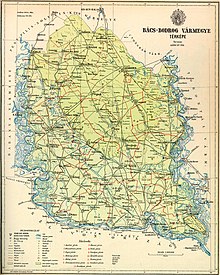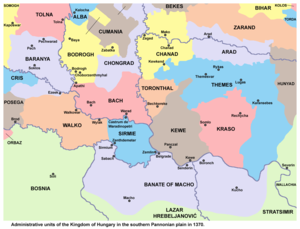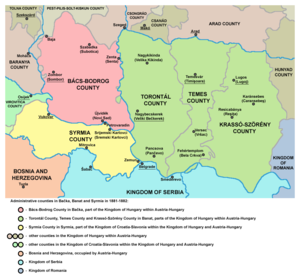
Bács-Bodrog County
This article needs additional citations for verification. (April 2009) |
| Bács-Bodrog County | |
|---|---|
| County of the Kingdom of Hungary (1802-1849, 1860-1946) County of the Second Hungarian Republic (1946-1949) County of the Hungarian People's Republic (1949-1950) | |
| 1802–1 February 1950 | |
 | |
| Capital | Zombor Baja (1920-1941, 1945-1950) |
| Area | |
• 1910 | 10,362 km2 (4,001 sq mi) |
• 1930 | 1,685 km2 (651 sq mi) |
| Population | |
• 1910 | 812,385 |
• 1930 | 137,403 |
| History | |
• Established | 1802 |
• Disestablished | 18 November 1849 |
• County recreated | 27 December 1860 |
• Treaty of Trianon | 4 June 1920 |
| 11 April 1941 | |
• Merged into Bács-Kiskun County | 1 February 1950 |
| Today part of | Serbia (8,677 km2) Hungary (1,685 km2) |
| Sombor is the current name of the capital. | |
Bács-Bodrog County (Hungarian: Bács-Bodrog vármegye, German: Komitat Batsch-Bodrog, Serbian: Бачко-бодрошка жупанија, romanized: Bačko-bodroška županija) was an administrative county (comitatus) of the Kingdom of Hungary from 1802 to 1920. Most of its territory is currently part of Serbia, while a smaller part belongs to Hungary. The capital of the county was Zombor (present-day Sombor).

Name
The county was named after two older counties: Bács and Bodrog. Bács county was named after the town of Bács (present-day Bač) and Bodrog county was named after the historical town of Bodrog (which was located near present-day Bački Monoštor), which itself was named after the Slavic tribe of Abodrites (or Bodrići in Slavic) that inhabited this area in the Middle Ages. The Abodrites were originally from northwest Germany, but after their homeland fell to the Germans, some had moved to Pannonia.

Geography

Bács-Bodrog county shared borders with several other counties of the Kingdom of Hungary: Baranya, Pest-Pilis-Solt-Kiskun, Csongrád, Torontál, Syrmia, and Virovitica (the latter two counties were part of the autonomous Kingdom of Croatia-Slavonia). The river Danube formed its western and southern border. The river Tisza formed its eastern border, down to its confluence with the Danube. Its area was 10,362 km2 (4,001 sq mi) around 1910.

History

Bács county arose as one of the first[citation needed] counties of the medieval Kingdom of Hungary, in the 11th century. Bodrog county was also formed in the 11th century.[1] The area was taken by the Ottoman Empire in the 16th century [2] and the two counties were abolished. During the Ottoman administration, the area of the former counties was part of the Sanjak of Segedin. The Bács and Bodrog counties were established again after the Bácska region was captured by the Habsburg monarchy in 1699;[3] later, the two counties were joined into a single county in 1802.[citation needed] Some (mostly eastern) parts of Bácska were incorporated into the Theiß-Marosch section of the Military Frontier.[3] After this part of the Military Frontier was abolished in 1751, these parts of the Batschka were also included into Bács-Bodrog county. The only part of the Batschka region which remained within the Military Frontier was Šajkaška, but it too came under civil administration in 1873.


In 1848/1849, the area of the county was claimed by the self-proclaimed Serbian Voivodeship, while between 1849 and 1860 it was part of the Voivodeship of Serbia and Banat of Temeschwar, an official crown land of the Empire. During this time the county did not exist since the area was divided into districts. The county was recreated in 1860, when the Voivodeship of Serbia and Banat of Temeschwar was abolished and the area was again incorporated into the Habsburg Kingdom of Hungary.

By the Treaty of Trianon of 1920, the territory of the county was divided between the Kingdom of Serbs, Croats and Slovenes and Hungary. Most of the county (including Sombor, Subotica, and Novi Sad) was assigned to the Kingdom of Serbs, Croats and Slovenes (renamed to Yugoslavia in 1929), while the northernmost part (approximately 15% of the county), including town of Baja, was assigned to Hungary.

Aftermath
Until 1922, the southern part of the former Bács-Bodrog county was a de facto province of the Kingdom of Serbs, Croats and Slovenes with the seat in Novi Sad. The capital of the smaller Hungarian county of Bács-Bodrog was Baja.

The former Yugoslav part of the pre-1920 Bács-Bodrog county was occupied and annexed by Hungary in 1941 and Bács-Bodrog county was extended to its historic boundaries. After World War II, the border between Yugoslavia and Hungary was restored in 1947 by the Paris Peace Treaties and the county's territory was reduced again. The Yugoslav part of the former Bács-Bodrog county was later divided into 3 districts and is currently part of the Serbian autonomous region of Vojvodina.

In 1950, Bács-Bodrog was united with the southern part of the former Pest-Pilis-Solt-Kiskun county to form the Bács-Kiskun county.

Demographics

During the 18th century, the Habsburgs carried out an intensive colonisation of the area, which had low population density after the last Ottoman wars. The new settlers were primarily Serbs, Hungarians, and Germans. Because many of the Germans came from Swabia, they were known as Donauschwaben, or Danube Swabians. Some Germans also came from Austria, and some from Bavaria and Alsace. Lutheran Slovaks, Rusyns, and others were also colonized, but to a much smaller extent. According to the Austrian census from 1715, Serbs, Bunjevci, and Šokci comprised 97.6% of the county's population.

The 1720 census recorded 104,569 citizens in the county. Of those, there were 98,000 Serbs (divided into 76,000 Orthodox and 22,000 Roman Catholics, or Bunjevci and Šokci), 5,019 Magyars and 750 Germans. The Serbs (73%) and Bunjevci and Šokci (21%) had an overwhelming majority in the county at that time.

There was also an emigration of Serbs from the eastern parts of the region, which belonged to Military Frontier until 1751. After the abolishment of the Theiß-Maros section of Military Frontier, many Serbs emigrated from north-eastern parts of Batschka. They moved either to Russia (notably to New Serbia and Slavo-Serbia) or to Banat, where the Military Frontier was still in place.

By 1820, the county had grown to 387,914 in total population. The Serb (including Croats, Bunjevci and Šokci) share had dropped to 44% or 170,942, with the number of Hungarians rising to 121,688 and Germans to 91,016, or 31% and 23%, respectively.


| Census | Total | Hungarian | German | Serbian | Slovak | Ruthenian | Other or unknown |
|---|---|---|---|---|---|---|---|
| 1880[4] | 638,063 | 234,352 (38.52%) | 162,894 (26.77%) | 177,081 (29.10%)[b] | 24,761 (4.07%) | 7,294 (1.20%) | 2,062 (0.34%) |
| 1890[5] | 716,488 | 288,521 (40.27%) | 189,051 (26.39%) | 197,104 (27.51%) | 29,025 (4.05%) | 9,063 (1.26%) | 3,724 (0.52%) |
| 1900[6] | 766,779 | 327,108 (42.66%) | 192,267 (25.07%) | 139,412 (18.18%) | 30,068 (3.92%) | 10,055 (1.31%) | 67,869 (8.85%)[c] |
| 1910[7] | 812,385 | 363,518 (44.75%) | 190,697 (23.47%) | 145,063 (17.86%) | 30,137 (3.71%) | 10,760 (1.32%) | 72,210 (8.89%)[d] |
| Census | Total | Roman Catholic | Eastern Orthodox | Lutheran | Calvinist | Jewish | Greek Catholic | Other or unknown |
|---|---|---|---|---|---|---|---|---|
| 1880 | 638,063 | 407,003 (63.79%) | 121,838 (19.09%) | 57,238 (8.97%) | 24,227 (3.80%) | 17,141 (2.69%) | 8,696 (1.36%) | 1,920 (0.30%) |
| 1890 | 716,488 | 461,027 (64.35%) | 131,303 (18.33%) | 64,810 (9.05%) | 27,934 (3.90%) | 19,115 (2.67%) | 9,983 (1.39%) | 2,316 (0.32%) |
| 1900 | 766,779 | 498,216 (64.98%) | 138,344 (18.04%) | 68,526 (8.94%) | 29,261 (3.82%) | 18,793 (2.45%) | 10,814 (1.41%) | 2,825 (0.37%) |
| 1910 | 812,385 | 534,682 (65.82%) | 146,015 (17.97%) | 70,098 (8.63%) | 29,772 (3.66%) | 18,244 (2.25%) | 11,684 (1.44%) | 1,890 (0.23%) |
As for the geographical distribution of the four largest ethnic groups in 1910, Hungarians mainly lived in the northern parts of the county, Germans in the western parts, Croats (including Bunjevci and Šokci) around Szabadka and Serbs in the southern parts. The city of Újvidék in the southern part of the county was the cultural and political centre of the Serbs in the 18th and 19th centuries.

Subdivisions
In the early 20th century, the subdivisions of Bács-Bodrog county were:

| Districts (járás) | 
| |
|---|---|---|
| District | Capital | |
| Apatin | Apatin (now Apatin) | |
| Bácsalmás | Bácsalmás | |
| Baja | Baja | |
| Hódság | Hódság (now Odžaci) | |
| Kula | Kula (now Kula) | |
| Óbecse | Óbecse (now Bečej) | |
| Palánka | Palánka (now Stara Palanka) | |
| Titel | Titel (now Titel) | |
| Topolya | Topolya (now Bačka Topola) | |
| Újvidék | Újvidék (now Novi Sad) | |
| Zenta | Zenta (now Senta) | |
| Zombor | Zombor (now Sombor) | |
| Zsablya | Zsablya (now Žabalj) | |
| Urban counties (törvényhatósági jogú város) | ||
| Baja | ||
| Szabadka (now Subotica) | ||
| Újvidék (now Novi Sad) | ||
| Zombor (now Sombor) | ||
| Urban districts (rendezett tanácsú város) | ||
| Magyarkanizsa (from 1908; now Kanjiža) | ||
| Zenta (now Senta) | ||
The towns of Baja and Bácsalmás are now in Hungary; the other towns mentioned are now in Serbia.

Earlier subdivisions
In the early 19th century Bács-Bodrog County was divided into:[8][9]

- Processus Superior or Felső járás ("upper district"): the north-western part of the county, including Baja
- Processus Medius or Közép járás ("middle district"): the western part, centred on Zombor (Sombor), which also included Apatin and Bezadán (Bezdan)
- Processus Inferior or Alsó járás ("lower district"): the southern part, including Bács (Bač), Neoplanta (Uj-Vidék/Novi Sad/Neusatz) and Ó-Futak (Futog)
- Processus Tybiscanus or Tisza járás ("Tisza district"): the eastern part, including Maria Theresianopolis (Szabatka/Subotica), as well as Ó-Becse (Bečej), Temerin, Zenta (Senta) and Kis-/Magyar-Kanizsa (Kanjiža)
Šajkaška was part of the Military Frontier at this time.

See also
Notes
References
- ^ "File: Hungary 1038 domb.jpg, (6631 × 4569 px)". lazarus.elte.hu. Archived from the original on 2012-03-06. Retrieved 2015-10-04.
- ^ "File: Hungary 1568 domb.jpg, (5683 × 3917 px)". lazarus.elte.hu. Archived from the original on 2016-03-04. Retrieved 2015-10-04.
- ^ a b "File: Hungary 1699 domb.jpg, (5683 × 3998 px)". lazarus.elte.hu. Archived from the original on 2016-03-04. Retrieved 2015-10-04.
- ^ "Az 1881. év elején végrehajtott népszámlálás főbb eredményei megyék és községek szerint rendezve, II. kötet (1882)". library.hungaricana.hu. Retrieved 2021-09-28.
- ^ "A Magyar Korona országainak helységnévtára (1892)". library.hungaricana.hu. Retrieved 2021-09-29.
- ^ "A MAGYAR KORONA ORSZÁGAINAK 1900". library.hungaricana.hu. Retrieved 2021-09-29.
- ^ "KlimoTheca :: Könyvtár". Kt.lib.pte.hu. Retrieved 2021-09-29.
- ^ Lipszky, Janos; Gottfried, Prixner; Karacs, Ferenc (1808). "Mappa Generalis Regni Hungariae". David Rumsey Map Collection. Pesthini. Retrieved 2023-09-07.
- ^ Gorog, Demeter (1802). "Bács és Bodrogh törvényesen egyesült Vármegyék (Comitatus Bacsiensi et Bodrogiensis)". David Rumsey Map Collection. Retrieved 2023-09-07.
See what we do next...
OR
By submitting your email or phone number, you're giving mschf permission to send you email and/or recurring marketing texts. Data rates may apply. Text stop to cancel, help for help.
Success: You're subscribed now !


